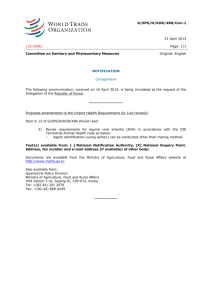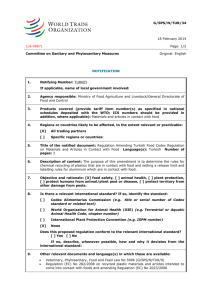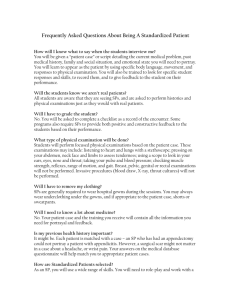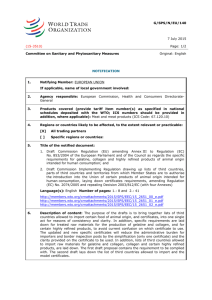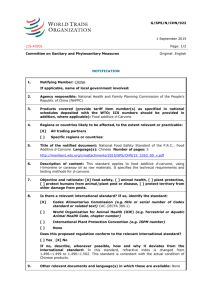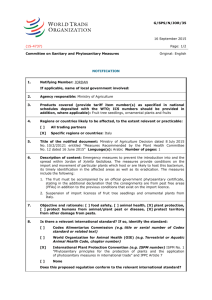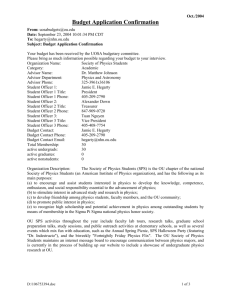The Implementation of SPS Agreements
advertisement
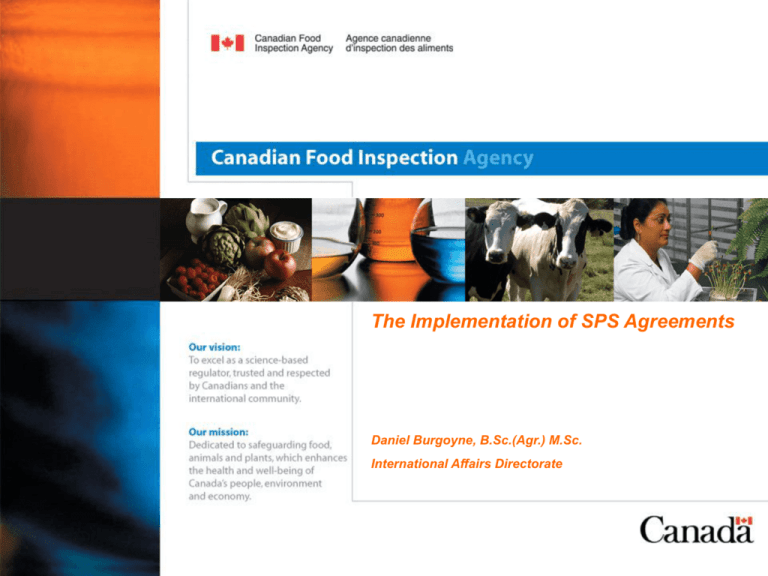
The Implementation of SPS Agreements Daniel Burgoyne, B.Sc.(Agr.) M.Sc. International Affairs Directorate Canada’s Context Canada is a large country with a small population • Smaller internal demand than production capacity • Major agri-food exporter for grains, oilseeds, pulses, animals, meat and forestry products Canada has long and cold winters • Costly to grow fresh fruits and vegetables • dependency on imports of fresh fruits and vegetables 2 How Canada deals with large trade flows Regulatory and science-based decision making Professional and stable workforce able to plan projects over the long term Laboratories for food, animals and plants Procedures and regulations are transparent 3 Unique approach to managing food safety, animal health and plant protection CFIA was created in 1997 by the unification of 4 inspection ministries • Agriculture – animal, plant and processed fuits and vegetables • Health – unregistered food sector under the Food and Drugs Act • Fisheries and Oceans – fish and seafood inspection • Industry – consumer protection e.g labelling, weights and measures, etc. Inherited a large network of laboratories across the country 4 What does CFIA do? Conduct « on-the-gound » inspection Set standards and regulate animal health, plant protection Manages food recalls • not only for tainted food or undeclared allergens but also when the food presents a danger e.g. choking for children Independant Agency - reports to the Minister of Agriculture 5 Risk Analysis CFIA performs risk assessments for imports of products of animal and plant origin for concerns related to animal health and plant protection • Within CFIA, risk assessment work is at arm’s length from risk management and risk communication activities Health Canada performs risk assessments for human health concerns 6 What does Health Canada do? Sets standards for all food • Nutrition • Fortification • MRLs • Contaminants • Microbiology Approves veterinary drugs Approves pesticides 7 Canada Border Services Agency (CBSA) Separate entity Conducts inspections at the points of entry (border, airports, seaports) CFIA is not present at the border unless called in by CBSA to deal with unexpected issues 8 International representation CFIA represents Canada at the World Organisation for Animal Health (OIE), the International Plant Protection Convention (IPPC) and the North American Plant Protection Organisation (NAPPO) Health Canada and CFIA rotate chairs for representation at the Codex Alimentarius Commission At SPS Committee Meetings, CFIA leads a multidepartmental team with delegates from Health, Agriculture and Trade Ministries 9 The WTO SPS Agreement – Meeting our Obligations In developing new standards and regulations • Using the principle of non-discrimination between domestic and imports for products of similar risk profiles • Consistent with OIE, IPPC and Codex guidelines and recommendations • Science-based justification when implementing measures above international standards 10 Being Transparent Notifications • Notification of all new measures which: • • deviate from an internationally agreed standard, recommendation or guideline have a significant impact on trade • Give members sufficient time to comment ahead of the final adoption of the measure to take comments into consideration • Provide other members translations of background documents via the Secretariat when available 11 Enforcing our Rights Bilaterally • Raise issues with our trade partners and sharing information at the expert’s level first • Use our network of embassies abroad to make representations to other governments, in their language. • at first, not a formal, heavy, diplomatic approach but rather by direct contact, phone and emails • delivering letters from CFIA to our counterparts • these posts also report back on issues and receive information from CFIA in order to be up-to-date • elevating if approach has not yielded results 12 Enforcing our rights (2) At the SPS Committee • If elevating issue at diplomatic level has not worked, intervention at Committee is considered • Use the opportunity to meet on the side of the meeting in Geneva to resolve before the formal meeting • Report positively to the Committee if progress made 13 Discuss Policy Canada holds regular meetings with « like-minded » trade partners e.g. New Zealand, Australia Canada participates actively in Committee discussions aimed at maintaining the SPS Agreement and influencing the debate over the Agreement’s interpretation 14 How we prepare for the SPS Meetings • Throughout the year, notifications are reviewed and comments are prepared, when necessary, on: • issues that affect our exports directly or indirectly • measures that are not science-based • measures inconsistent with SPS Agreement • CFIA coordinates papers, development of positions, interventions and bilateral and informal meetings 15 How we prepare for the SPS Meetings (2) • Canada advises WTO Secretariat of issues for agenda • Briefing notes are prepared, distributed inside CFIA and outside CFIA for comments before approval by Head of Delegation • Formal instructions are drafted for the Canadian delegation 16 Issues under discussions recently at SPS Committee Equivalency Regionalisation Special and Differential Treatment Review of the SPS Agreement 17 Equivalency Provisions • Canada applies whenever possible to improve efficiency e.g. with USA, we have no formal declaration of equivalency but on meat exports, we sign USDA certificates • Prefer a systems basis with audit rather than plant by plant approval • With Mexico, we have started an exercise in reciprocal recognition of the two systems which is an equivalence of outcomes and not how the inspection is performed • e.g. pork • This was applied successfully to other trading partners, most recently Brazil and Chile 18 Regionalisation • Canada supports the developement of regionalisation guidelines by the standard setting bodies e.g. IPPC – ISPM 15 • We have regionalised other countries e.g. Brazil for Newcastle disease, the European Union for highly pathogenic avian influenza • Countries have regionalised Canada e.g. avian influenza 19 Regionalisation (2) • Another example in following the recent discovery of Golden Nematode in the province of Québec • US/Idaho had also found last spring • in 6 weeks, USA and Canada were able to develop conditions for regulated areas which allow products outside the areas to be traded 20 Review of SPS Agreement Canada has proposed 3 items: • Clarification of terms: Measures vs. Regulations • Clarification on relationship between SPS Committee and the international standard setting bodies (OIE, IPPC, Codex) • Transparency in notifying all measures (including those not based on the ISSB’s) 21 Special and Differential Treatment Doha/ Development Round – make S&DT provisions of Agreement more « precise » • Canada supports further work to assist the Committe address underlying concerns of developing countries • How to make greater use of SPS Committee • How to effectively evaluate which SPS requirements of trade partners present trade problems 22 Other SPS Arrangements • NAFTA – formal • European Union – veterinary agreement • Chile – SPS Committee • Brazil – SPS Mechanism 23 Results • Routine contacts at professional and scientific level • Cooperation on regulatory issues • Mutual understanding of each others’ regulatory systems • Exchange of ideas and technologies 24 Conclusion • The SPS Agreement is relatively new • It has presented challenges for all members • Canada had to adapt its organisational structure to cope • Since its adoption in 1995, we have seen an evolution • Measures need to be based on sound scientific principles • Requires commitment to participate in International Standard Setting Bodies (OIE, IPPC and Codex) 25 Future Will things stay static? NO! • The SPS Agreement will reach its maximum usefulness if we have: • full participation of its members and, • full implementation of its principles 26 27
